Succulents are very popular at the moment and for good reason too. They come in a huge range of colors and shapes There is no doubt that succulents are a hot trend right now. They are available in a variety of colors and shapes and make wonderful indoor plants. Listed below are 14 of the most popular types of flowering succulents, along with information about their appearance, growth habits, and care.
Aloe Barbadensis (True Aloe)
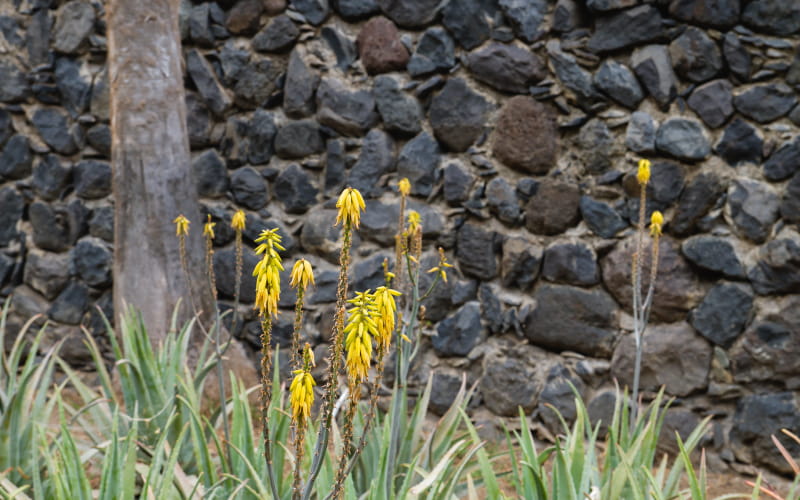
Aloe barbadensis is a succulent plant species of the genus Aloe. It is a very common succulent and used for medicinal purposes and is very easy to care for. It produces yellow flowers on stalks that rise above the succulent.
Depending on growing conditions and location, flowers can appear any time of year, but are most common between spring and early summer. Aloe tolerates poor soil and drought, but requires good drainage and bright sunlight, but also tolerates some shade. Water when dry.
Opuntia (Prickly Pear Cactus)
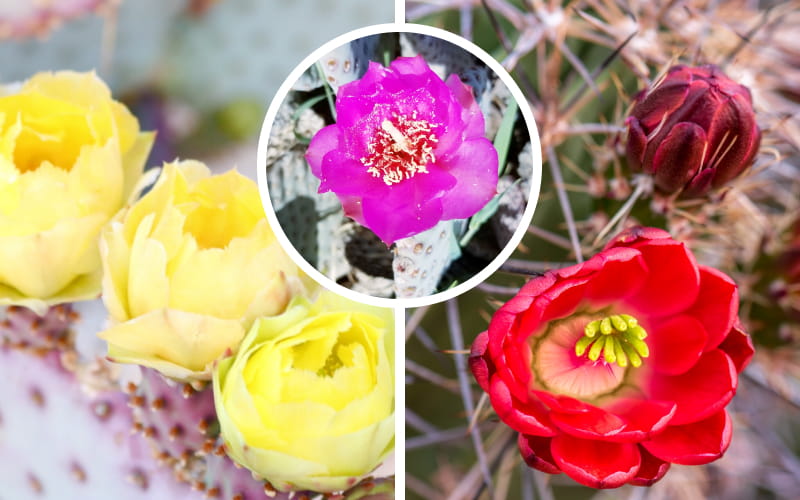
There are many names for Prickly Pear. They are also called tuna, sabra, nopal, and paddle cactus. Optunia is edible. It produces delicious fruit. This succulent blooms grow in a variety of colors in the spring. The color of blooms varies, but they usually are yellow, red, or purple. Opuntias can grow to be 10 to 15 feet tall.
Opuntias require full sun and well-draining soil. Water when dry. Plant them at the same level at which they are currently growing, since their shallow roots can cause root rot if planted deeper. Fruit and beautiful succulent flowers make Opuntias a wonderful addition to any garden.
Curio rowleyanus (String of Pearls)
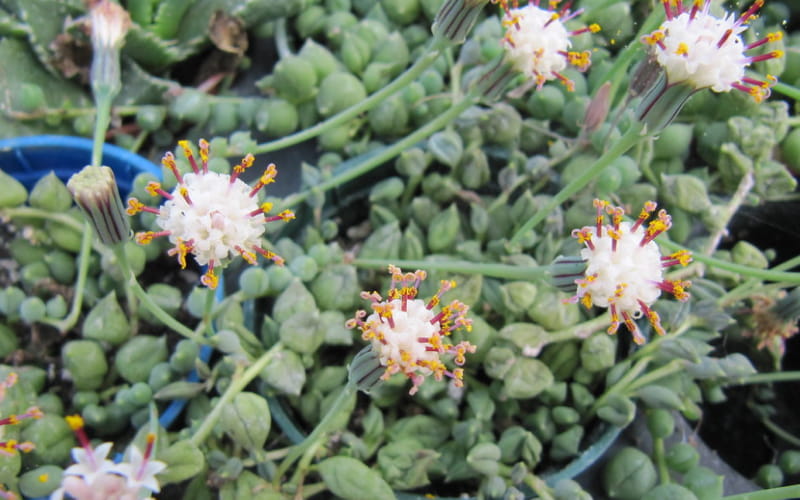
Curio Rowleyanus (syn Senecio Rowleyanus) is a creeping perennial vine found in South West Africa. This is one of my favorite flowering succulents. Its stems trail on the ground and root wherever they touch, forming dense mats. Its flowers are daisy-like, white, with long red stamens and yellow anthers. It blooms from spring to autumn. Although the flower buds are not showy, they are fragrant, with a pleasant cinnamon scent. String of Pearls prefers well-draining soil, partial shade outdoors, and bright sunlight when grown as an indoor succulent. Water when dry. Protect it from harsh sunlight.
Ruschia pulvinaris (Creeping Shrubby Ice Plant)
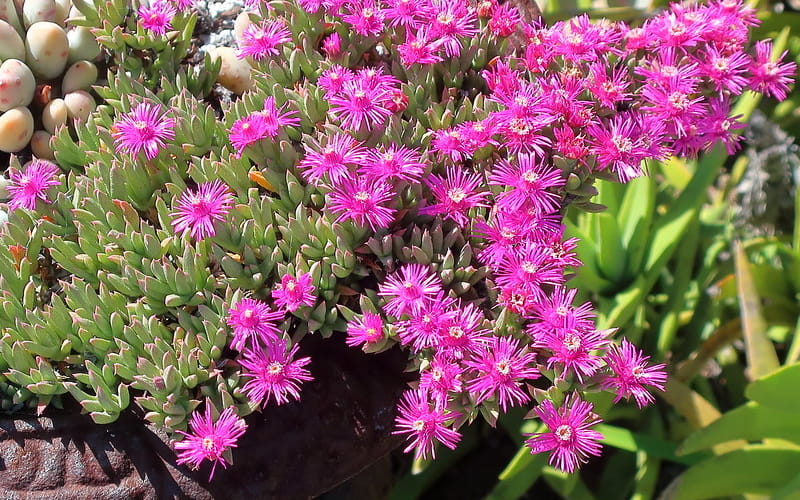
Ruschia pulvinaris is also known as shrubby ice plant and congested ice plant. This is a low growing succulent that grows compactly to the ground and is perfect for a rock garden. This succulent bears bright pink flowers from spring through summer. Requires full sun and fast draining soil.
Lithops helmutii (Living Stones)
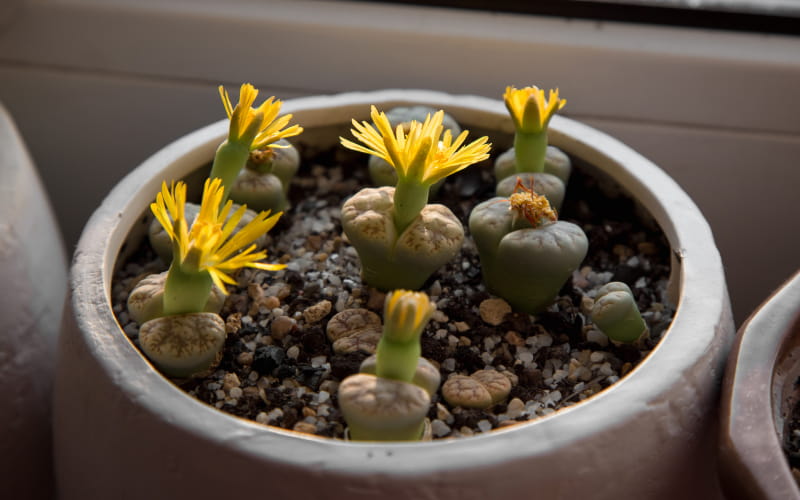
Lithops are among the most fascinating succulents in the world, coveted by succulent collectors. Among the few naturally occurring green Lithops species, Lithops helmuti has a large semitransparent to transparent window. The upper surfaces of its plump leaves are oblique and have gray markings. Golden yellow flowers appear between each “stone” at the end of summer. Requires well-draining soil and bright sunlight. Living stones need very little water and care. Shield from cold temperatures.
Hatiora gaertneri (Easter Cactus)
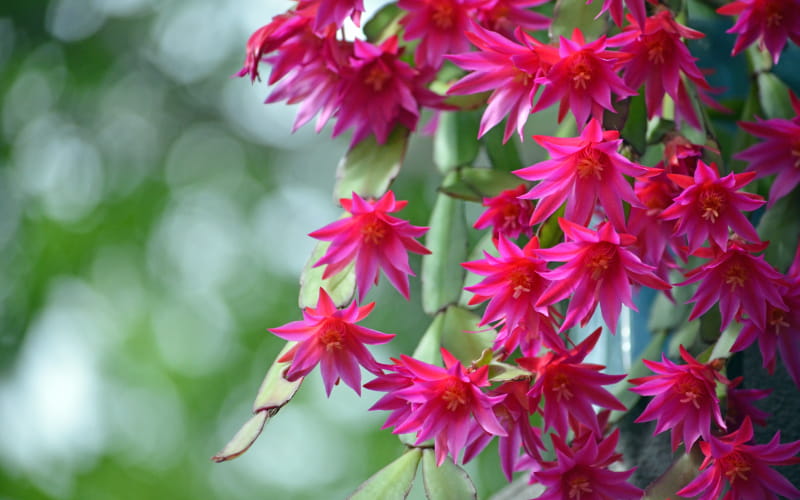
The Easter cactus is known as Schlumbergera gaertneri. It is a perennial cactus that has flat stems that are divided into segments by notched edges.
During spring, scarlet flowers appear in profusion, either in single blooms or in clusters. It is possible for your Easter cactus to bloom twice in one year if you are lucky. Indirect light and non-abrasive sunlight are best for this succulent. It prefers well-draining soil and only water when completely dry.
Crassula Perforata (String of Buttons)
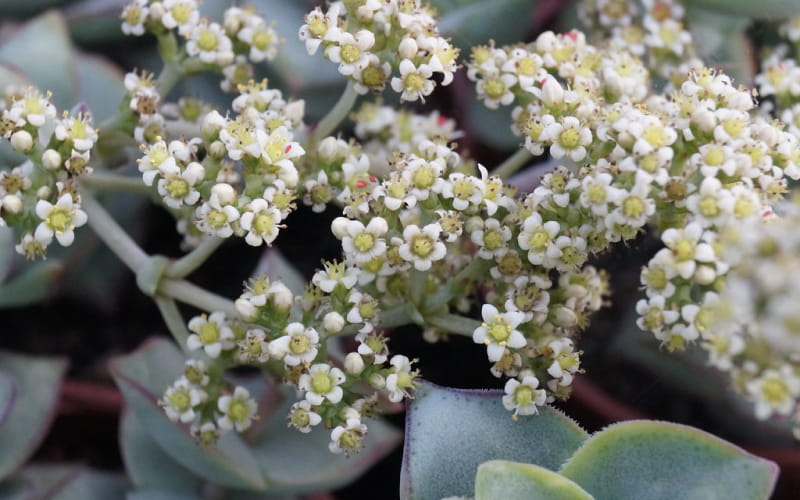
Crassula Perforata is also known as Necklace Vine, String of Buttons, and Pagoda plant. It is a small, compact succulent shrublet that stays low and clumps easily. This succulent has a stacked appearance. Its leaf margins often have red tinges. In the right conditions, it can bloom at any time of year with small, white, sweet-smelling flowers. Provide as much light as possible when kept as an indoor succulent, while outdoors they can tolerate partial to full sunlight. Ideally, they need well-draining soil, and they need water only when dry.
Sedum x Rubrotinctum (Jelly Bean Plant)
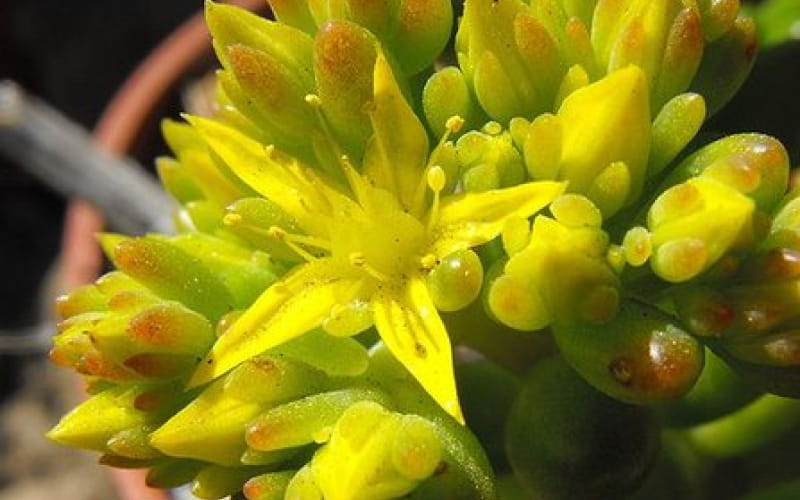
Sedum Rubrotinctum is known as Pork and Bean, Pork-n-beans, Jelly Beans, Baby’s-toes, Brownbean Sedum, Jelly bean plant.
It is a miniature hybrid of Sedum pachyphyllum and Sedum stahlii, Sedum rubrotinctum is commonly known as a jelly bean plant. The flowers are bright yellow with a reddish tint, and they bloom mid spring. This succulent prefers full sun and well-draining soil. Once established, Sedum Rubrotinctum is drought and heat tolerant. Water when dry.
Graptosedum (Francesco Baldi)
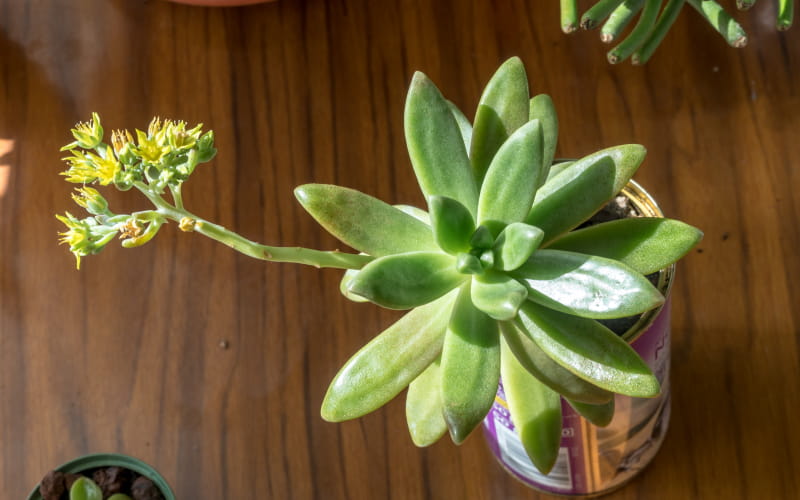
Graptopetalum cv. ‘Francesco Baldi’ is an interspecies hybrid between two Crassulaceae species native to Mexico: Graptopetalum paraguayense and Sedum pachyphyllum.
It grows star-shaped yellow flowers are bountiful and produced more in this species than in many others. It blooms in late winter and early spring. The colors of this succulent change with the seasons. This succulent is best grown in well-draining soil with lots of sunlight.
Sempervivum Arachnoideum (Cobweb Houseleek)
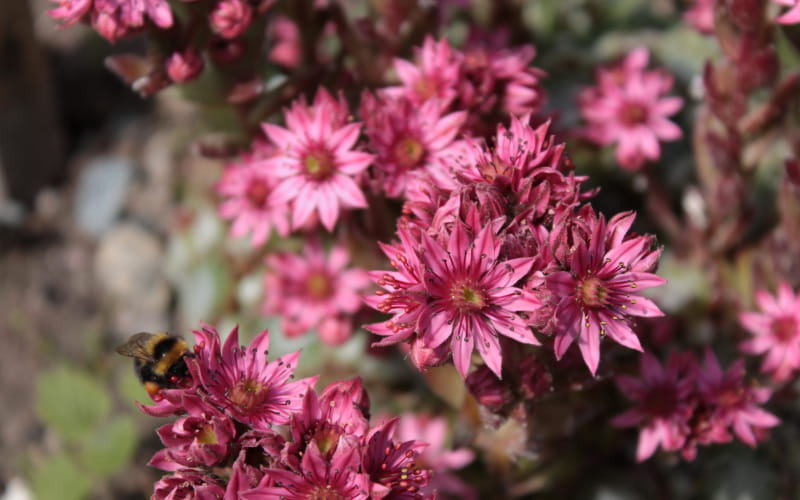
Sempervivum Arachnoideum is also known as Hens & Chicks or Cobweb Houseleek. It is a small, evergreen cold hardy perennial succulent that grows in tight rosette forming mats, often grown in rock gardens.
Usually pink, the flowers can also be white, or bright red, and they grow from stems that extend from the succulent during late summer. This is a monocarpic plant, so the rosette that produces the stem will die. Sempervivum Arachnoideum requires full sun and well-draining soil, and should be completely dry between watering.
Echeveria cv. Afterglow
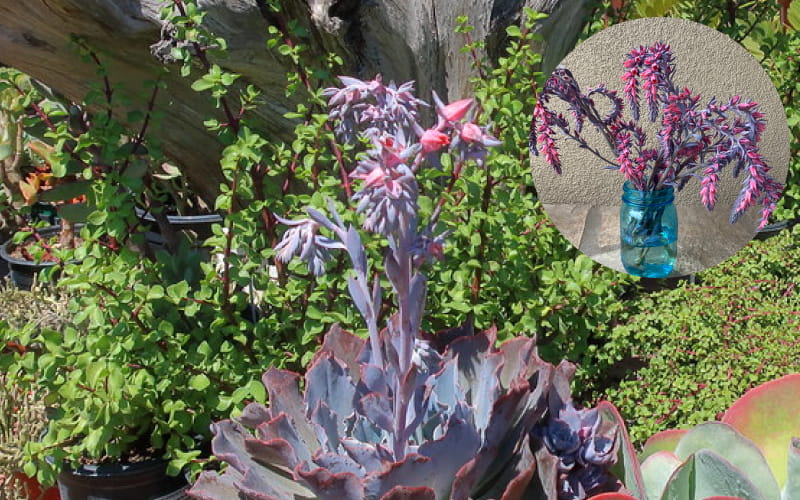
Echeveria Afterglow has powdery pink, and blue pastel leaves with a bright pink edge. All aspects of this succulent are impressive, from the flowers to the stalks. In summer, deep orange-red flowers emerge from below lower leaves or as a bloom stalk. It grows best in sandy, gritty, well-drained soil and partial shade, while its best color develops in full sun exposure. Once growth is established, it is drought-resistant and heat-tolerant.
Othonna capensis (Little Pickles)
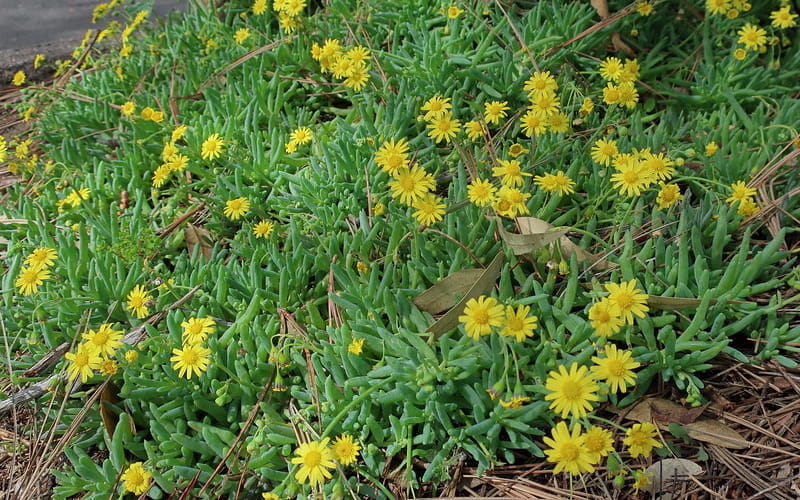
Besides the common name Little Pickles, Othonna capensis is also referred to as Othonna. A perennial succulent herb, Little Pickles are slightly woody at the base. It branches freely and resembles pickled cucumbers. Stress can cause the leaves to turn yellow, lavender, and red.
The flowers are yellow and daisy-shaped, appearing in spring through autumn and sometimes year-round. The flowers initially appear as violet pea-shaped buds, the blossoms persist as small white puffs after blooming. Prefers full sun to partial shade in well-draining soil.
Kalanchoe daigremontiana (Mother of Thousands)
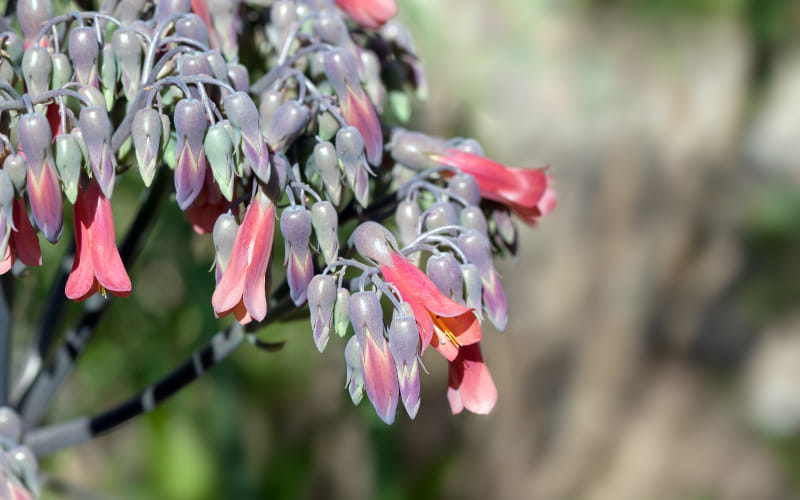
Kalanchoe daigremontiana is also known as Mexican Hat Plant, Alligator Plant, Devil’s Backbone, and Chandelier Plant. It is a perennial succulent that spreads by growing small plantlets from the leaf margins. It can grow to be 3 feet tall.
Mother of Thousands is a monocarpic succulent. Kalanchoe daigremontiana has large, bell-shaped flowers that are rose, pink, or lavender and grow on an almost umbrella-like flower stalk. They bloom in winter when grown indoors. As they can be invasive outdoors, keep the mother plant in a pot if you want to prevent it from spreading. They prefer bright light, but need to be shielded from harsh sunlight. Prefers well draining soil and water only when dry. Like most Kalanchoe, it can live without regular fertilizer. Mother of Thousands is considered a drought-tolerant succulent.
Crassula Ovata (Jade Plant)
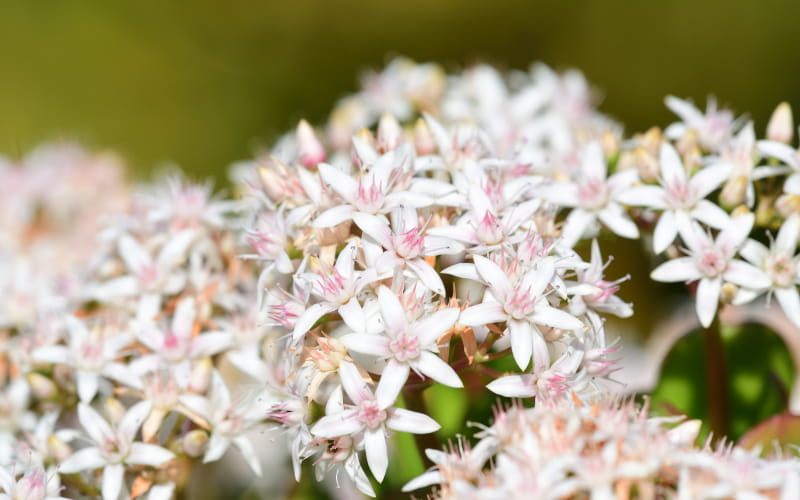
This succulent is known as Kerkei Bush, Jade Plant, Money Tree, Jade Tree, Dollar Plant, Lucky plant, Friendship Tree, Japanese Rubber, Dwarf Rubber, Chinese Rubber, Cauliflowers Ears, and Baby Jade Plant. Jade plant is a multibranched, very floriferous bonsai-like succulent with glossy, flattened green leaves. These succulents have leaves that are rounded and shiny jade-green with or without red margins. This plant rarely blooms as a houseplant, but when it does, it has white flowers tinged with pink.
It does best in full sun and well-drained soil. A reddish tinge of color will appear at the leaf margins when it is in full sun. You should protect young jade succulent plants from harsh direct sunlight to prevent scorching. It prefers temperatures between 65 and 70 degrees Fahrenheit and grows beautifully as an indoor plant. Expanded care information here.
This article highlights 14 types of flowering succulents that are beautiful, easy to maintain, and easy to care for. The key to keeping these succulents happy is soil with great drainage, plenty of light to encourage growth, watering when the soil is dry, and occasional fertilizer. You may have to adjust how often you water them depending on your climate.
Similar Topics in: Succulent Trends, Succulents
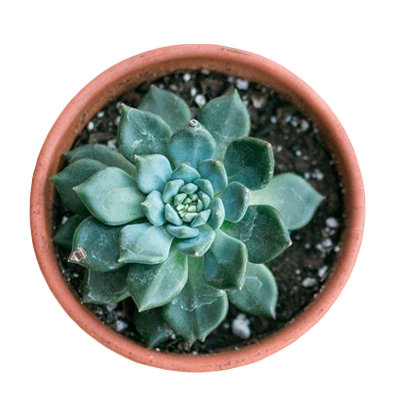
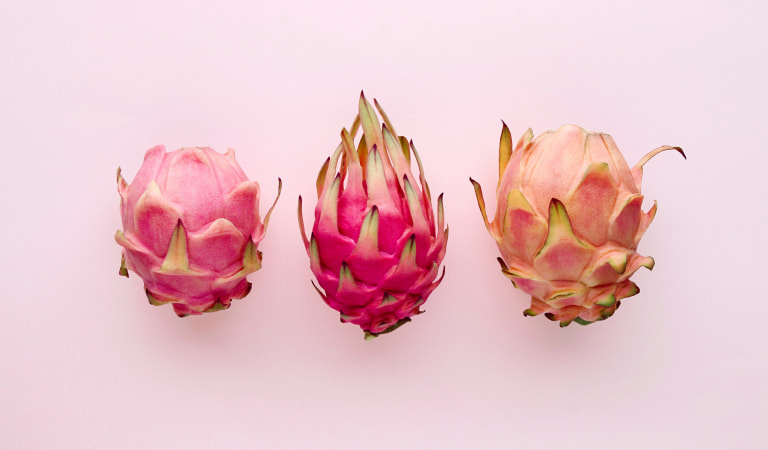
Leave a Reply